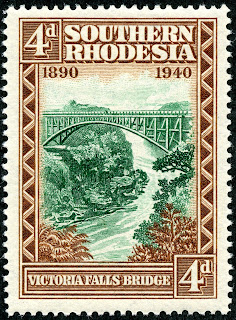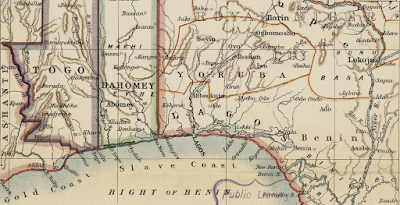1931 Scott 26 1sh turquoise blue & black "George V"
Quick HistoryBefore 1923, the territory was administered by the British South Africa Company. By way of history, BSAC, which governed and administered the lands by Royal Charter from 1889-1923, named the territory north of the Zambezi "Northern Rhodesia", and the lands south of the Zambezi "Southern Rhodesia". Both territories were called by the white settlers, "Rhodesia", after Cecil Rhodes, the founder of BSAC.
1911 Encylopaedia Britannia Map of Rhodesia
The Zambezi River bisects the lands into
Northern Rhodesia (North Western & North Eastern) & Southern Rhodesia
In 1923, the BSAC no longer administered the territories, and Southern Rhodesia (1924-1964), at the request of the inhabitants, became a self governing crown colony. (To confuse things, it was known as "Rhodesia", -although not recognized as such internationally- from 1965-1979.) With independence in 1980, it became Zimbabwe.
Southern Rhodesia
More precisely, a 1922 referendum showed 59% of voters favoring "responsible government" rather than joining the Union of South Africa.
The capital was Salisbury (name changed to Harare after independence), and the population was 38,000 whites (4%) and 922,000 blacks (96%) in 1927.
Stamps were issued under "Southern Rhodesia" between 1924-1953. (One definitive set was issued in 1964 also.)
Northern Rhodesia became a British Protectorate from 1924-1964. With independence in 1964, the name was changed to Zambia.
(My blog post for Northern Rhodesia has more maps and explanation of these turbulent times.)
At the same time, Southern Rhodesia (or "Rhodesia"), south of the Zambezi, was turned over to the white settlers, who established highly discriminatory laws against the black African majority, who outnumbered the white settlers By 10:1- despite an influx of 200,000 immigrants largely from the British working class between 1945-1970.
Southern Rhodesia joined the Federation of Rhodesia and Nyasaland (Also known as Central African Federation -"CAF") between 1953-1963. The first stamp for the Federation was issued in 1954.
When Northern Rhodesia became independent as Zambia in 1964, the conservative white minority government of Southern Rhodesia unilaterally declared itself independent, and called itself "Rhodesia". The status was not internationally recognized, as it was clearly an attempt to continue with a discriminatory white policy.
The outlaw character of the country persisted until 1979, when the Constitution of Zimbabwe-Rhodesia was passed, and Zimbabwe was recognized as independent in 1980.
1924 Scott 2 1p scarlet "George V"
Into the Deep BlueThe 2014 Scott Classic Specialized 1840-1940 catalogue has, for Southern Rhodesia 1924-1951, 78 major descriptive numbers. Of those, 40 are CV <$1-$1+, or 52%.
A closer look at the stamps and issues
12 Pence = 1 Shilling
20 Shillings = 1 Pound
1924 Scott 3 1 1/2p bister brown "George V"
The first issue of Southern Rhodesia was an engraved 14 stamp set produced between 1924-30 with the "admiral" design. This was a continuation of the Rhodesia 1913-23 "admiral" issue.
Without a doubt, this is one of the better "looks" for George V.
CV for six stamps is <$1-$3+.
Without a doubt, this is one of the better "looks" for George V.
CV for six stamps is <$1-$3+.
1933 Scott 16 1/2p deep green "George V"
A 13 stamp engraved issue (by Waterlow) with the 3/4 "George V" vignette was released between 1931-37. Various perfs- given minor numbers in Scott- can be found for this issue.
1931 Scott 22 6p rose lilac & black "George V"
The higher denominations are bicolored. CV for the 1931-37 issue is <$1-$3 for eight stamps.
1932 Scott 32 3p dark blue "Victoria Falls"
Also printed by Waterlow, but typographed, were 2p and 3p denomination "Victoria Falls" stamps in 1931. A lovely design indeed.
1941 Scott 37 2p dark brown & green
"Postage and Revenue"
Between 1935-41, a similar two stamp "Victoria Falls" issue, but with "Postage and Revenue" script along the top frame, was produced.
1937 Scott 39 2p brown & green
"Queen Elizabeth, George VI"; Coronation Issue
An interesting "Coronation Issue" (compared to most other British colonies with their use of the common design type) shows Victoria Falls with a train and "Victoria Falls" railroad bridge in the foreground.
1937 Scott 53 2sh6p violet & blue "George VI"
A 13 stamp set was released in 1937 for definitive use showing George VI in full naval regalia. CV is <$1-$1+ for 10 stamps.
"Seal of British South Africa Company"
A wonderful eight stamp bicolored engraved issue was released in 1940 for the 50th anniversary of the founding of Southern Rhodesia by Cecil John Rhodes. More correctly, it was the founding of the British charted British South Africa Company on the lands that were called ""Rhodesia".
1940 Scott 57 1p red & violet blue "Fort Salisbury, 1890"
Named after the then British Prime Minister, the city was founded in 1890 by the Pioneer Column, in the service of Cecil Rhodes and the British South Africa Company.
Hosting the Flag at Fort Salisbury on September 13, 1890 (Unknown Artist)
The Pioneer Column was used to obtain rights to the territory of Mashonaland and Matabeleland kingdoms within the future Southern Rhodesia- and quickly, before the Germans, Boers or Portuguese did. ;-)
1940 Scott 58 1 1/2p copper brown & black
"Cecil John Rhodes"
Cecil John Rhodes, very much an archetype of the British imperialist, believed in the positive benefits of colonialism. And to make himself rich through his businesses and mining. ;-)
If one reads the histories of the development of British South Africa, Cecil John Rhodes either is treated with "chauvinistic approval" or "utter vilification" (Quote from historian Richard A. McFarlane).
Certainly, one nice legacy, funded by his estate, was and is the Rhodes Scholarships.
1940 Scott 59 2p purple & bright green
"Pioneer Fort and Mail Coach"
Fort Victoria was also founded by the Pioneer Column in 1890 on their way to Salisbury.
1940 Scott 60 3p dark blue & black
"Rhodes makes Peace, 1896"
The British South Africa Company had their own police force, which they used to control Matabeleland and Mashonaland. This lead to the First Matabele War (1893-94) against the Ndebele Kingdom, and the Second Matabele War (1896-97), also known as the Matabeleland Rebellion, against the Ndebele, and seperately, the Shona.
Cecil Rhodes and the Ndebele make peace in the Matopos Hills
(Robert Baden-Powell - 1896)
Rhodes walked unarmed into the Matopos Hills encampment and successfully persuaded the Ndebele to stop fighting, Thus ended the Second Matabele War.
1940 Scott 61 4p brown & blue green
"Victoria Falls Bridge"
The railway bridge, built in 1905, is located below Victoria Falls, and crosses the Zambezi River.
Victoria Falls Bridge, under construction, 1905
It was inspired by Rhodes's desire - never fulfilled- to build a railroad from "Cape to Cairo". He wanted the trains, as they went over the bridge, to "catch the spray of the falls".
1940 Scott 62 6p sepia & dull green
"Sir Charles Coghlan"
Charles Coghlan was the first Premier and Prime Minister of self governing Southern Rhodesia (1923-27). A lawyer by trade, he earlier lead the "responsible government" movement, and opposed joining the Union of South Africa.
1943 Scott 64 2p prussian green & chocolate "Mounted Pioneer"
For the 50th anniversary of Matabeleland under British control, a stamp was issued in 1943 honoring the Pioneer Column.
Under the leadership of Frank Johnson, the 250 man force- chosen from the sons of local rich families to help insure British help if they should falter- were successful with their mission. The Pioneer volunteers were each awarded 3,000 acres and 15 mining claims.
Under the leadership of Frank Johnson, the 250 man force- chosen from the sons of local rich families to help insure British help if they should falter- were successful with their mission. The Pioneer volunteers were each awarded 3,000 acres and 15 mining claims.
Deep Blue
1937 Definitive Issue in Deep Blue
Deep Blue (Steiner) has seven pages for the stamps of Southern Rhodesia. The Steiner "classic" package pages include part of the regular issues of 1953 also, but not those of the Queen Elizabeth II era.
All Scott major numbers have a space.
All Scott major numbers have a space.
1935 Scott 33 1p carmine rose & olive
"Victoria Falls and George V"; Silver Jubilee Issue
Big Blue
Big Blue '69, on 1 2/3 page, has 51 spaces for 1924-1940 Southern Rhodesia. The pages are located between Somali Coast and South Africa, with Southern Nigeria sharing 1/3 page.
Subtracting the post 1940 issues in the 1840-1940 catalogue (17 stamps), the coverage in Big Blue is 84%- very good.
Five stamps are CV $10+-$20+.
Checklist
Subtracting the post 1940 issues in the 1840-1940 catalogue (17 stamps), the coverage in Big Blue is 84%- very good.
Five stamps are CV $10+-$20+.
Checklist
1924
1,2,3,4,5,6,7,
1924
8,9,(10),(11),
1931-34
16,17,
1931-34
18,21, 19,20,22,23,
1931-34
24,25,26,
1932
31,32,
Next Page
1935
33,34,35,36,
1937
38,39,40,41,
42,43,44,45,46,47,48,
1937
49,50,
1935-38
37,37A,
1940
56,57,59,60,
58,61,62,63,
Comments
A) Expensive stamps ($10 threshold):
1924 Scott 8 8p gray green & violet ($10+)
1924 Scott 9 10p rose red & blue ($10+)
1924 Scott (11) 1sh6p yellow & black ($20+)
1931 Scott 20 3p dark blue ($10+)
1935 Scott 36 6p dark violet & black ($10+)
B) ( ) around a number indicates a blank space choice.
1940 Scott 63 1sh dark blue & bright green
"Victoria, George VI, Lobengula's Kraal and Government House"
Out of the Blue
Fascinating- both the stamps and history.
Note: Maps, drawings, and pics appear to be in the public domain.
Comments appreciated!






























































